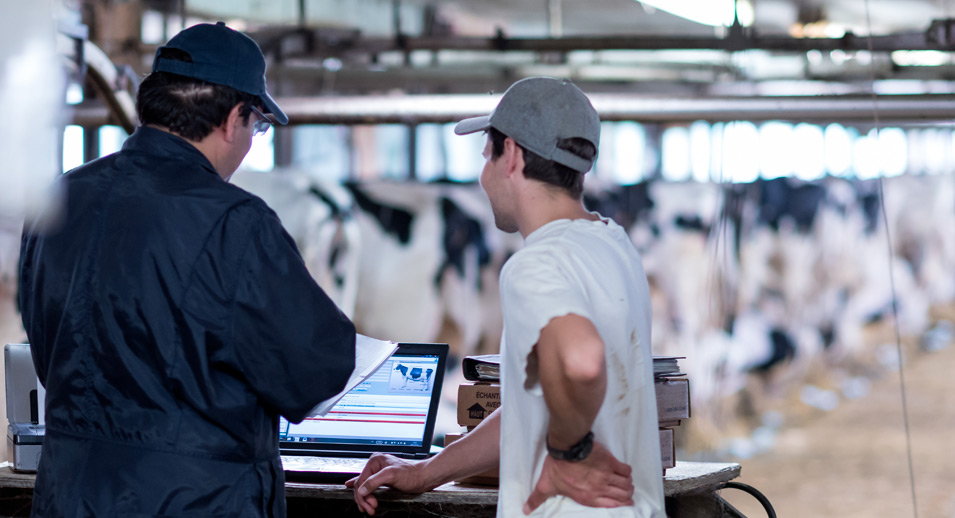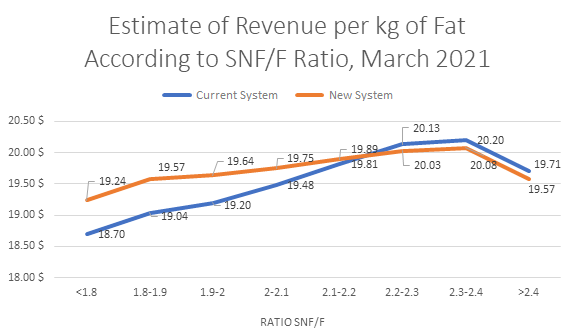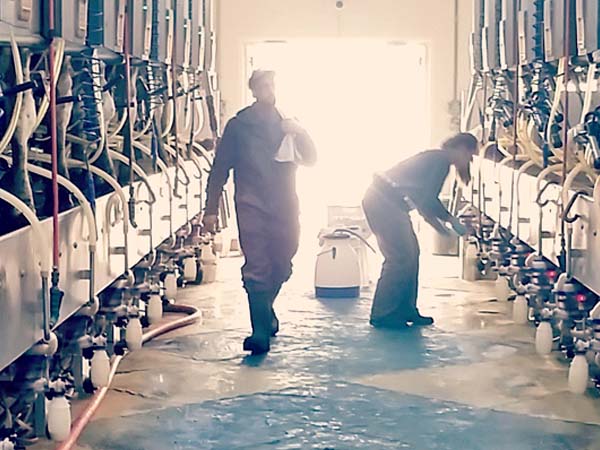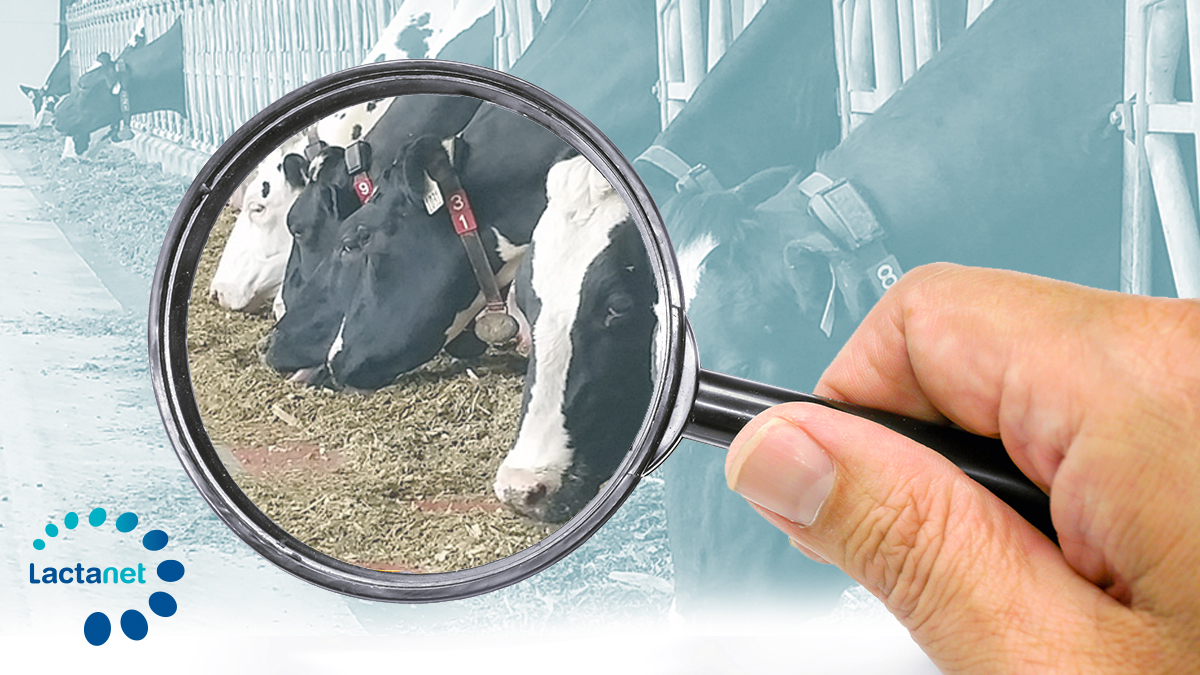The new milk payment policy: it doesn’t change the world, but…
- August 7, 2021
You have already heard about the arrival of a new milk payment policy for Quebec producers that has started on August 1st, 2021 so I will not look at the justification for this change nor the details of the calculation of the new prices. Instead, I will focus on the impact that this could have on the daily decisions that producers make.

Some win and some lose?
The following graph is taken from a video that was used to present the new system. This video is available on the Producteurs de lait du Québec web site. The graph compares milk revenue per kg of fat based on the Solids Non-Fat /Fat ratio (SNF/F).

On this graph, the blue line represents the current system, and the orange line the system that was put in place in August 2021. You can see that those with the lower ratios will profit from a significant increase in revenue in $/kg fat whereas the higher ratios will have their advantage slightly reduced. The difference in average price received of $0.93/kg milk fat for producers with a ratio of 2.2 to 2.3 versus those with 1.9 to 2.0, will be reduced to $0.49/kg under this simulation.
How does all of this work?
The price of protein for interior demand will be increased (ratio 2.0 or less) whereas that of the surplus protein will be somewhat reduced to align with global prices (ratio 2.0 to 2.3). Previously, it was all paid at the same rate up to a maximum ratio of 2.3.
Despite this change, you can see that the revenue per kg of fat continues to increase up to a maximum ratio of 2.3 whereas surplus protein and lactose and other solids (L.O.S.) are paid at $0/kg. As such, for the same quantity of fat delivered, producers with a SNF/F ratio of 2.3 will receive a higher paycheck than those at 2.0. In this case, is it worth it to try and modify the composition of the milk that you deliver in the future?
Do Your Homework
I propose that you carry out this little exercise to examine the best strategies for you to adopt once the new payment policy is in place. My examples are drawn up using the monthly prices for May in Ontario where the new system has been in place since February 1st, 2021.
Bordeleau farm owns 100 kg/day of quota. Their average milk fat over the past year is 4.15 kg/hl (ratio SNF/F of 2.20). Although they knew that they could have reached an average of 4.25 kg/hl (ratio SNF/F 2.16), the owners calculated that with the previous payment policy their paycheck would have decreased by a little more than $360/month if they had chosen this road. What about with the new payment policy?
Table 1. Net Monthly Revenue for Delivered Milk, New System1
| Delivered Milk (l) | Fat kg/hl | Protein kg/hl | L.O.S. kg/hl | Ratio SNF/F | Total Net Revenue ($) | $/kg Fat Delivered |
Current Situation | 72,300 | 4.15 | 3.24 | 5.91 | 2.20 | 56,645 | 18.88 |
Improved Fat Levels | 70,600 | 4.25 | 3.28 | 5.91 | 2.16 | 56,525 | 18.84 |
1 May 2021 prices, Ontario
Table 1 shows us that despite differences in milk fat of 0.10 kg/hl, the difference in net revenue is much lower with the new policy ($120 vs. $360). This is also evident when you compare the price per kg of delivered milk fat: this difference is only 0.04 $/kg milk fat.
The big question: does the extra $120/month earned with a ratio of 2.20 cover the cost of producing the extra 1,700 litres? At 35 litres per cow per day, this represents 1.6 more cows at the lowest fat content. As far as I am concerned, I doubt that $4 /day is enough to cover the feed costs of these extra cows. Some of you will have noticed that the protein levels are not identical for the two lines. This situation reflects what we usually observe: protein levels have a tendency to evolve in the same direction as milk fat.
Now let’s repeat the exercise, but as a short-term situation. In August 2021, the farm had 70 cows in milk. These cows produced an average of 35 litres per day. The owners were hoping to fill the allotted extra day. The high heat and humidity that they saw throughout the month had a negative impact on the animals’ feed intake and this had repercussions on the milk fat, resulting in a drop of 0,15 kg/hl as compared to the yearly average. Table 2 shows us how this effected the paycheck for the month.
Table 2. Net Revenue for Delivered Milk for August 2021, New System1
| Delivered Milk (l) | Fat kg/hl | Protein kg/hl | L.O.S. kg/hl | Ratio SNF/F | Net Total Revenue $ | $/kg fat delivered |
Current Situation | 73,500 | 4.00 | 3.15 | 5.91 | 2.26 | 55,530 | 18.89 |
Improved Fat Levels | 73,500 | 4.10 | 3.21 | 5.91 | 2.22 | 56,910 | 18.88 |
Here, you can see that the drop in fat levels had a less significant impact on herd revenue with the improved rate because there are more total solids for the same volume delivered. Despite the 0.15 kg/hl decrease, the improved rate allowed them to produce the extra day and even a bit more. They would also have been able to do it with the current system as long as the rate would have remained at the annual average. Let’s just say that the safety margin was greater with the improved rate.
Conclusion
The new milk payment policy has considerably reduced the extra revenue resulting from a high SNF/F ratio. Effectively, the price paid for non-fat solids beyond the ratio of 2.0 has decreased as compared to the old system (-40% with the prices used in our example). Also, the price is bound to fluctuate quite a bit, according to the state of the world market to which it is aligned. This market is currently undergoing a good period, but things can change quickly at this level. It will therefore be important to monitor whether the differences truly cover the additional operational costs related to the production of these surplus non-fat solids. If this is not the case, take a closer look at what you can do to profitably improve milk fat levels in your herd and use this opportunity to reduce your workload.











